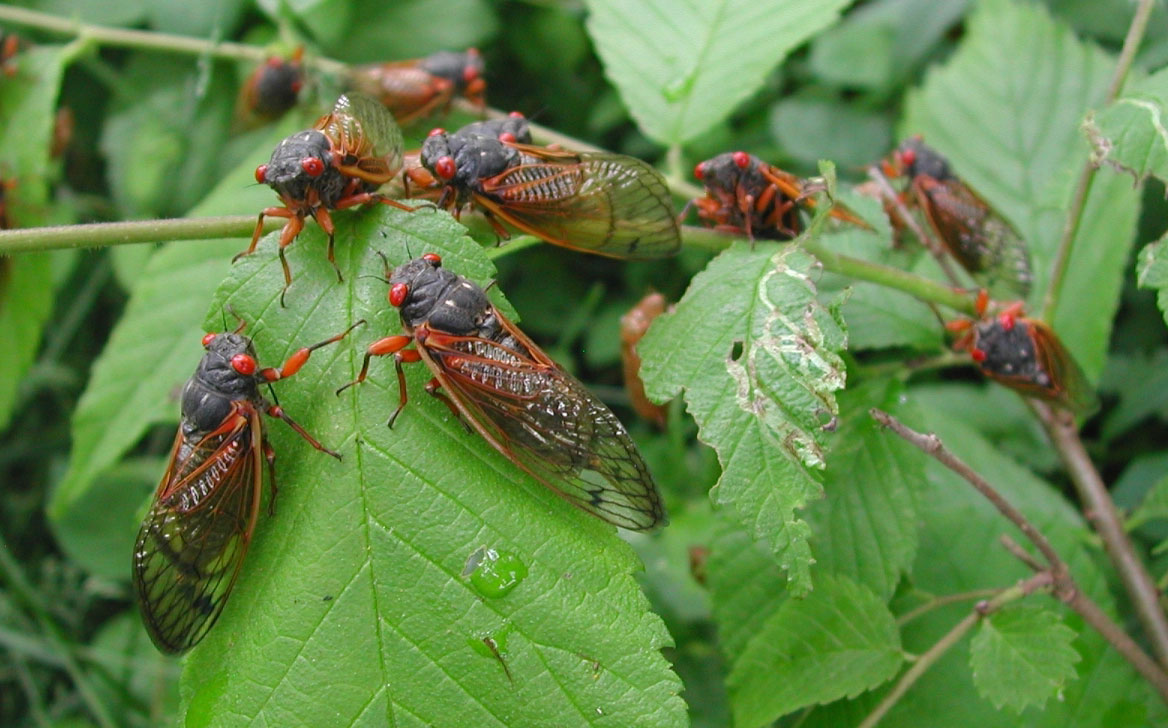The infamously loud chorus made by periodical cicadas is able to be detected by fiber cables through an emerging technology called distributed fiber optic sensing. [Image: Pennsylvania Department of Conservation and Natural Resources-Forestry, Bugwood.org]
In an era of unprecedented insect decline due to climate change, entomologists looking to monitor insects might have an unexpected new sensing tool: optical fiber.
Through what one author describes as “serendipity,” US researchers studying distributed sensing in fiber optic networks have reportedly used distributed acoustic sensing (DAS) in the fiber to measure the chorusing of cicadas (J. Insect Sci., doi: 10.1093/jisesa/iead090). The team believes the work constitutes the first entomological application of such a method—and hopes the technique can be expanded to leverage standard fiber optic cables to gain new insights into cicadas.
Vibrational disturbances
DAS works by detecting and analyzing backscatter in fiber optic cables. When a highly coherent optical pulse is sent down a cable, Rayleigh scattering off of tiny, inherent imperfections in the fiber sends a small fraction of the light back toward the source. A sufficiently strong acoustic event along the cable will cause a time-varying strain at the point of the disturbance, which modulates the local refractive index and, in turn, the optical phase of the backscattered light from that spot.
The time delay of the backscattered light indicates the location of the disturbance, while variations in the modulated backscatter can be tied to the frequency and volume of the sound that caused the disturbance. The technique is proving increasingly useful in detecting natural events such as earthquakes, volcanic eruptions and the movement of glaciers, as well as in “smart city” applications such as traffic management (see “DAS: A Seismic Shift in Sensing,” OPN, June 2021).
A 50-km length of cable with a spatial resolution of 1 m, for example, is comparable to installing 50,000 sensors across the same geographic distance.
Some researchers think DAS has the potential to turn the world’s existing fiber optic infrastructure into a vast sensing network, without expensive, time-consuming modifications or added external power. “We can turn every meter of the fiber into a kind of vibrational sensor,” says Sarper Ozharar, a researcher at NEC Labs America, USA, and the lead author on the new study. A 50-km length of cable with a spatial resolution of 1 m, for example, is comparable to installing 50,000 sensors across the same geographic distance.
A serendipitous swarm
Ozharar and his NEC Labs team were initially testing DAS as a tool for smart-city applications such as detecting emergencies through the sound of gunshots and monitoring traffic. One morning in June 2021, however, the researchers were alarmed to find part of their fiber-sensing test apparatus—standard outdoor-grade telecommunications cables hung from three 35-foot utility poles—covered in cicadas. The insects, the swarms of which are famed for their near-deafening “chorus” of buzzed sound, belonged to the largest periodic cicada brood, Brood X. And they were emerging from underground for the first time in 17 years.
After the initial surprise, the researchers realized that the large swarm offered an opportunity to detour from their original study plans. The team found that the cicadas’ buzzing was loud enough to be detected by the fiber cables, making the swarm a perfect candidate to explore a novel environmental application.
The team sent a stream of 8-ns-wide pulses, at repetition rates of 2 to 20 kHz, through its testbed of outdoor telecom fiber, and used an off-the-shelf DAS device from NEC to analyze the returns. Fourier analysis of the acoustic signal recovered from the DAS system picked up a peak frequency component at 1.33 kHz, which agreed nicely with the frequency of the cicadas’ chorus. Additionally, sampling at the lower repetition rate was able to detect the ebb and flow of the chorus pitch with time of day and even with ambient temperature. The same system was also able to track the decay of the total sound energy produced by the insects across several weeks—a proxy for changes in the insect population.
Beyond citizen science
Ozharar reached out to entomologist Jessica Ware at the American Museum of Natural History, USA, to confirm that the auditory data his team was gathering from cicadas were useful―and indeed they were. Entomologists have begun to rely on reports from “citizen scientists” (volunteers from the public) for information on cicada emergence times, chorus volume and population size. Such reports can be limited and skewed, however, by where people are located and how accurate their observations are. Distributed sensing in fiber provides a new potential source for the lowdown on cicada activity with fewer limitations. That could offer the prospect of continuous, long-duration, in situ data collection over large areas.
Ozharar sees this study as an excellent example of the importance of staying open-minded to the twists and turns of research.
While the experiments took place in a dedicated testbed, the authors stress that it comprises “standard outdoor telecommunication fibers” rather than specialty fibers, opening the opportunity for using the technique more generally in existing fiber networks. Although Brood X won’t return from underground until 2038, other cicada broods emerge in different years and areas of the United States. Those future appearances could thus offer entomologists with additional chances to leverage the country’s ever-growing fiber optic infrastructure.
Ozharar sees this study as an excellent example of the importance of staying open-minded to the twists and turns of research. “You truly never know where optics can be used next,” he said. “You start researching one application and end somewhere completely different than what you had in mind.”

